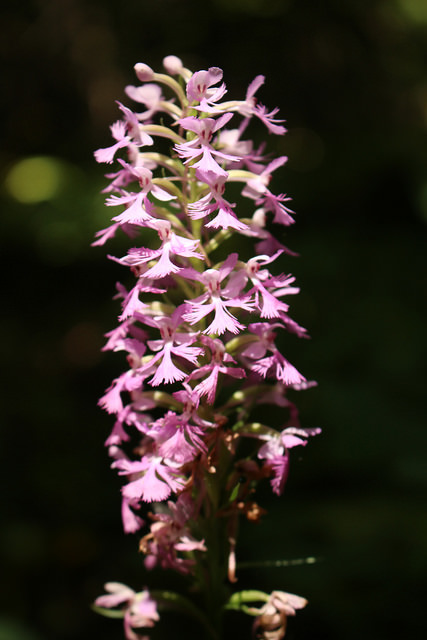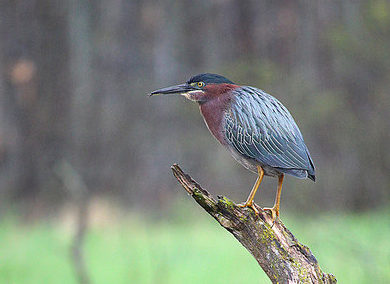The name “Audubon” often brings about visions of birdwatchers, those people who inexplicably grab their binoculars and start searching for things with wings. The Audubon Community Nature Center is much more than that. It is a place where classes on plants, gardening, wild edibles, fishing, trees and art are just as likely to be offered as a class on birds.
That said, the first Saturday in May is a traditional birding marathon, with Audubon staff and volunteers aiming to find an elusive 100 kinds of birds in 24 hours. Officially, it is called a birdathon, and it raises money for a local student going into an environmental career. Unofficially, it is a chance to gather as a large group and spend time hanging out, learning and discovering things together.

Soras are small, marsh-dwelling birds with a loud call that can be heard from Audubon’s Blue Heron Overlook. Photo by Jeff Tome
This year, the birdathon crew saw 96 different birds over the course of the day. For many, the gut reaction is that 96 birds is not a lot. After all, aren’t there over 900 different birds in North America? This is true, but many birds only migrate through this area or only spend part of the summer here.
The birds of May are a delightful mix of birds that nest locally and birds that are passing through to nest further north. Some birds flit high in the trees. Others lurk in shrubs or grass. Different birds live in different habitats and you have to visit all of them in order to find the many different birds of the area.
It becomes hard not to associate birds with their habitats. There is a delightful bird that only lives in shrubs and sings “witchedy, witchedy, witchedy”. This bird, known as a Common Yellowthroat, is one I have rarely seen, but listen for anytime I am near a shrubby thicket. It has even been in my backyard, where it likes the chaotic spread of the Ninebark bush in the corner of the yard and the tangled clump of currants nearby.
The forests are full of odd birds that flit about in the treetops. They have delightful names like Black-throated Green Warbler and Scarlet Tanager. They cause birders neck, also known as warbler neck, because of the awkward angle you have to hold binoculars to get a good look at the birds.
Other places are filled with different birds. Fields are full of meadowlarks and Bobolinks, singing their oddly fake songs. The piercing cry of a Sora echoes out of the marshes at Audubon, while Green Herons spook out of the tall grass at the pond edge.
Looking at birds all day requires a bit of focus that is lacking in me. I cannot resist getting on my hands and knees and investigating a patch of wildflowers or stare at a frog beside the pond. I didn’t see some birds because I was staring at plants, but I missed seeing the Spiny Soft-shelled Turtle because I was staring at a bird, or rather, trying to see a bird that kept eluding me.
 Some people keep track of nature like others keep track of sports. Instead of knowing the stats of each player, rankings of teams, or who did what when, they keep track of what’s happening outside. I know people who know what birds migrate through at what time of year, the best place to watch certain turtles lay their eggs and where and when to look for rare orchids and other plants in the area.
Some people keep track of nature like others keep track of sports. Instead of knowing the stats of each player, rankings of teams, or who did what when, they keep track of what’s happening outside. I know people who know what birds migrate through at what time of year, the best place to watch certain turtles lay their eggs and where and when to look for rare orchids and other plants in the area.
The naturalist mindset follows a different schedule, timed by seasons and seasonal events. It’s not hard for me to find someone waiting for a warm rainy night in spring to watch salamanders make their way to breeding pools or sneak out at night to find Great Horned Owls nesting. There are people who watch fox or coyote dens, develop relationships with turkeys in their woods or making yearly pilgrimages to visit patches of orchids.
A day of birding is a great thing, but there is also so much out there to look for. This morning, in my first five minutes of arriving at Audubon and checking on things in the backyard, I watched a Bald Eagle fly over with food in its talons, a mink bound up the trail, two families of geese with adorable yellow goslings, a Great Blue Heron, two rabbits and no Purple Martins, which were what I went out looking for in the first place.
It may be hard to fill a day with birds, but there is always something happening outside and Audubon is a great place to find it.
Audubon Community Nature Center builds and nurtures connections between people and nature. ACNC is located just east of Route 62 between Warren and Jamestown. The trails are open from dawn to dusk as is Liberty, the Bald Eagle. The Nature Center is open from 10 a.m. until 4:30 p.m. daily except Sunday when it opens at 1 p.m. More information can be found online at auduboncnc.org or by calling (716) 569-2345.


Recent Comments